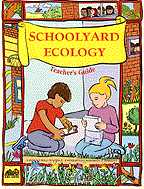Schoolyard Ecology
Grades 3—6
Written by Katharine Barrett and Carolyn
Willard
Whether your schoolyard is an ocean of blacktop or a little slice
of nature, this guide uncovers the animal organisms and plants
that share recess space with students every day. In this series
of outdoor investigations, children work in teams outdoors to
sample, record, and analyze information about living organisms
and their environment, and then return to the classroom to share
their findings and explore ecological, environmental, and life-science
concepts.
In the course of these activities, students learn biological sampling
techniques and develop mapping and related mathematical skills
recommended by the National Council of Teachers of Mathematics
for this grade range. Practicing gentle stewardship, they collect
temporary specimens—including ants, spiders, and other often-maligned
animals—in "shake boxes" in order to study them
as individual and interdependent organisms. There is ample opportunity
to relieve students of their fears of certain crawly creatures
and to explore why some animals seem to provoke such reactions.
Based on their observations and findings, students select small
areas as sample study sites, and summarize by writing about these
favorite locations in the closing activity. This guide is designed
to spark student curiosity about the patterns and interactions
in nature, beginning with their most immediate outdoor environment—the
schoolyard. It makes a great companion unit to such GEMS guides
as Ant
Homes Under the Ground, Buzzing
a Hive, Terrarium Habitats,
and Ladybugs.
Comment on this GEMS unit. |

Order
online
Ordering information
Literature Connections
Spanish Language Student Materials
What materials are needed to present this unit? See the full list. |
Reviews:
"In this era of hype about hands-on activities, the school
yard is too often given short shrift, except for occasional nature
walks. … The book, a product of a team effort, underwent
extensive tryout and review by teachers and specialists, and it
shows." — Science Books & Films
"Overall this is a very thorough presentation of five excellent
ecological activities for children. This is the way science should
be taught. The investigations encourage children to learn by 'doing'
and to discover for themselves how organisms interact with each
other and their environment. The activities are also invaluable
because they foster in children an appreciation and stewardship
for other living things. If they can be taught to value spiders
and ants, the rest will be easy." —The American Biology
Teacher |
| ISBN: |
Grade Level |
Format |
Price |
| 0-924886-35-8 |
3—6 |
5 Activities,
120 pages |
$20 |
|

